INTRODUCTION
Network attached storage devices have gone a long way since their early days so whereas even just 10 years they featured low-end single core CPUs and could just be used to house and share your crucial data on the local network today they have enough firepower to compete straight on even with full size server systems and can be used for a plethora of tasks. Of course at the end of the day NAS devices have yet to reach a point where they can replace regular servers all together but they can be used to host and shares files with other devices (file server), download files/data either directly or via the BitTorrent file distribution system, backup your system files, host your very own FTP server of website, connect one or more IP cameras and use it as a network video recorder and of course you can also use one as a complete home media DLNA server via which you can enjoy your media library on your TV screen (as long as it features an HDMI output) or stream it to compatible android/iOS devices. WD may not be the first manufacturer name that comes to mind when talking about NAS servers but they do own a respectable market share and with their latest My Cloud Expert series they aim even higher.
WD, a Western Digital company, is a long-time innovator and storage industry leader. As a storage technology pacesetter, the company produces reliable, high-performance hard disk drives and solid state drives. These drives are deployed by OEMs and integrators in desktop and mobile computers, enterprise computing systems, embedded systems and consumer electronics applications, as well as by the company in providing its own storage products. WD’s leading storage devices and systems, networking products, media players and software solutions empower people around the world to easily save, store, protect, share and experience their content on multiple devices. WD was established in 1970 and is headquartered in Irvine, California.
Just like with the My Cloud EX4 at first glance the EX2100 feels a lot like a mid-end NAS since falls somewhat short in terms of specifications compared to the competition (although it's definitely a step up compared to the EX4). So at the core of the EX2100 we find a Marvell Armada 385 (88F6821) dual-core CPU running at 1.3GH and 1GB DDR3 SDRAM. Two trayless 3.5" SATA 3 hot-swap drive bays are also present on the EX2100 along with 2 USB 3.0 ports and two RJ45 Gigabit Ethernet Ports (unfortunately unlike the EX4 the EX2100 doesn't have two DC in power ports thus you can't enable the power redundancy feature). WD currently sells the My Cloud Expert Series EX2100 either diskless (meaning you can use your very own drives) or ready right from the factory equipped with two WD Red 2/4/6TB drives (4/8/12TB total capacity) which you can configure either in JBOD or RAID 0/1. Today we'll be testing the 8TB model so let's not spend any more time in the introduction page.
SPECIFICATIONS AND FEATURES


PACKAGING AND CONTENTS
The EX2100 gets shipped inside a small box that has a product picture at the front and the available capacity (the diskless version should have none of that).
Two product pictures showcasing the front and rear of the device are placed on the left side right beneath three images showcasing some of its features.
Moving on the right side there are more features listed here along with the available capacity (more detailed however since it mentions the capacity of both drives).
The product features are also showcased at the rear of the box in 8 languages.
Packaging is very typical so the EX2100 is wrapped inside a plastic bag and placed between two foam spacers while the rest of the bundle is placed in yet another cardboard box.
The bundle contains exactly what you will need to start with the EX2100 so aside the device itself you will also get the power adapter with two power cords (UK/EU), Ethernet cable, user manual and a warranty information paper.
THE MY CLOUD EX2100 EXTERIOR
WD has used a similar design to the EX4 with the difference of two bays instead of four. In terms of size the steel & plastic enclosure of the EX2100 measures 216mm in length, 109mm in width and 147mm in height.
As you can all see the EX2100 is not that much different compared to the TS-251+-8G by QNAP (the EX2100 is slightly smaller).
A small section of the right side of the enclosure is perforated much like most NAS models in the market.
At the front of the device we find the two trayless 3.5" hot-swap HDD bays along with the power on/off button and a USB 3.0 port with the one touch backup button right over it (you can configure a backup task to start when this button is pressed).
Both drives jump out from the enclosure once you pull the bay covers (easier and much faster than using trays but it does restrict the user since the EX2100 supports only 3.5" drives - although you can always use 2.5" to 3.5" adapters).
WD has used a 70mm exhaust fan with the EX2100 and right next to it we find a Kensington lock, reset button, USB 3.0 port, two RJ-45 Gigabit Ethernet ports (support link aggregation) and the DC in.
THE MY CLOUD EX2100 INTERIOR
To open the enclosure you just have to remove the three screws found at the rear holding the main cover.
As usual we're not going to dismantle the entire NAS (very little reason to do so in the end) so instead we will took shots of some components like this aluminum heatsink placed over the dual-core Armada 385 CPU.
We also see two Marvell® Alaska® 88E1512 Gigabit Ethernet (GbE) transceivers and four SKhynix DDR3 SDRAM modules (256MB in size each).
SETUP
As usual i strongly recommend downloading the latest firmware update from the official WD support page prior to using the NAS.
The login screen is pretty much identical with that of the updated EX4.
Just like with the EX4 Prior to entering the web interface you will be required to agree with the end user license agreement and choose a language.
You will also be prompted to enable/disable automatic firmware updates and choose whether or not you want to join the product improvement product by allowing the NAS to send anonymous usage data to WD.
WEB INTERFACE PART 1



Once again the main page of the web interface gives you a good idea off what's going on with the NAS including the available space (here we see both WD RED drives in RAID 0), type of data on the NAS, connected devices, system health, firmware version, connected users (you can add more as you see fit) and installed applications.
If you click on the diagnostics tab you will see the current temperatures of both drives and the entire system.
You can also check for new firmware updates by clicking on the firmware tab.
Adding and removing users is very easy from the users screen (you can also separate them in groups).
You can manage all available shared folders on the NAS from the shares screen.
Allowing (or not) new devices to have access via cloud to your NAS can be done from the Cloud Access screen.
Local, remote and cloud backups are all available through the Backups page.



Changing the current drive mode, checking the current drive health and using iSCSI and Volume Virtualization can all be done through the Storage page.
WEB INTERFACE PART 2
Via the current (stock) installed apps the My Cloud EX2100 supports HTTP and P2P BitTorrent downloads (you can download files directly to the NAS) and can be also configured as an FTP server (you can create and monitor FTP accounts, setup access permissions, throttle bandwidth, manage IP blocking and use FXP).
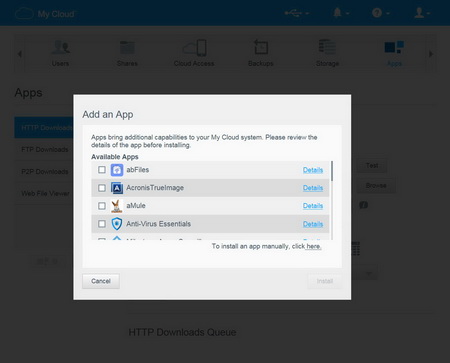
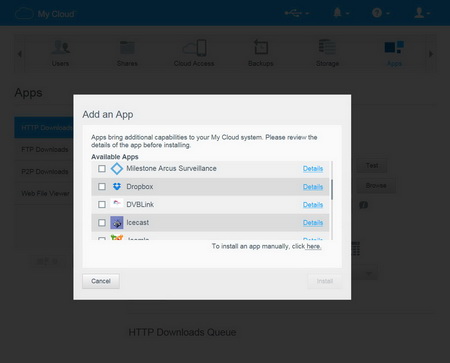


From here you can also download extra apps like abFiles (makes it easy to access files from mobile devices), Acronis TrueImage (clone drives, secure wipe drives and backup the operating system, applications, settings and all of your data) aMule and Transmission (P2P downloading), DropBox, DVBlink, Arcus Surveillance, Anti-Virus Essentials, IceCast (internet music streaming utility), Wordpress, phBB, phpMyAdmin, Joomla, Plex MediaServer, Logitech SqueezeCenter, Z-Way and NZBGet (you can also install 3rd party compatible apps).
Every setting regarding the NAS itself is placed under the Settings tab and from the General page you can change the name of the NAS, setup the time and language and you can also enable/disable cloud access, energy saving modes and time machine (MAC) backups.
Network related settings like services, windows services, remote server feature and port forwarding are all located inside the Network page.
You can run system diagnostics, format and check the drives for errors, hibernate and restart the NAS and create/share ISO images from within the Utilities page.
Although the NAS can be configured to automatically search for firmware updates you can also do so yourself from the firmware update page.
TESTING METHODOLOGY – PERFORMANCE RESULTS
Originally we had decided that since some of the NAS servers/devices we've tested in the past are no longer in our possession (naturally) we would keep performing the exact same testing methodology we did in the past for as long as possible in order to provide accurate comparison results. However since our real-life tests are not enough for some people we also decided to throw in ATTO and Crystal Disk Mark to cover the more demanding users. However as always we will be using up to six Seagate Constellation ES.3 4TB SATA III hard disk drive(s) with 3.5” compatible units and up to two (for now) Enterprise Capacity 2.5 HDD V3 2TB SATA III HDDs with 2.5” compatible units to perform several upload/download tests with 10.9GB (Single) and 40,8GB (RAID) files. Tests are repeated a total of 4 times after which we record the average numbers (from the 4 peak ones) into our charts. The network device used for 1GbE tests is the same Netgear D6300 AC1600 Gigabit ADSL2+ Modem/Router we’ve been using lately when performing tests on NAS servers. Since the 25th of June 2015 for 10GbE tests we’ll be using a Netgear ProSafe XS712T 10G Smart Switch and an Intel XT540-AT2 10GbE PCIe card (10GbE compatible NAS cards will be provided from each company and stated in each review). Finally both test systems we use when testing NAS devices are equipped with Kingston HyperX 480GB PCIe SSDs.
SINGLE DISK TESTS



RAID TESTS
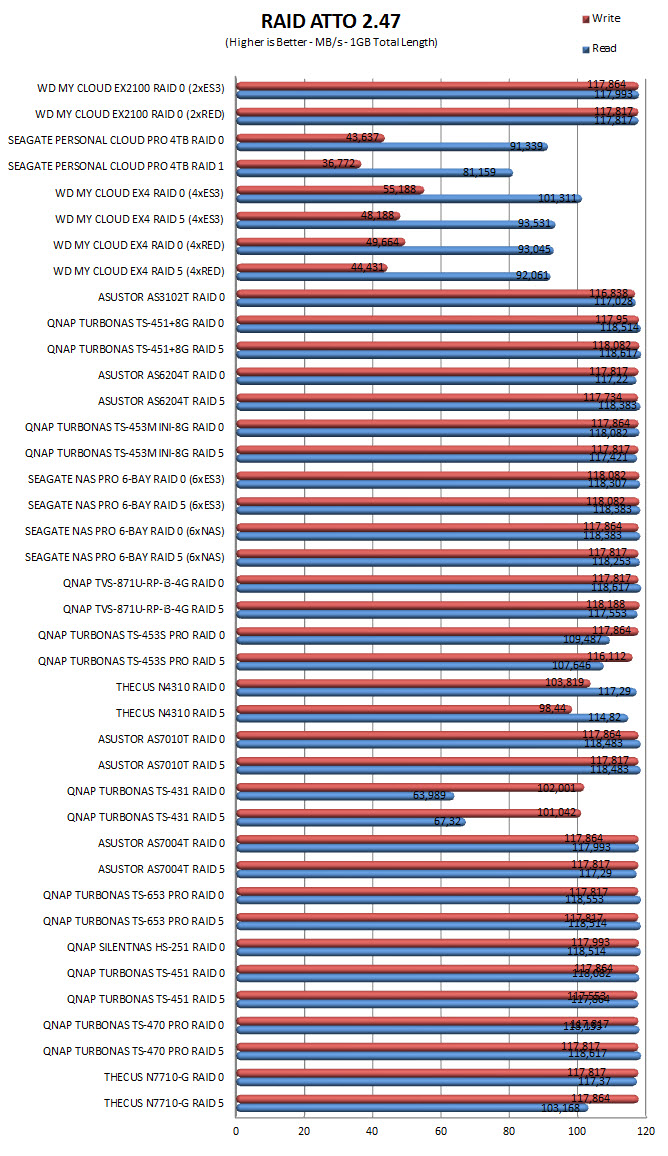


TEST RESULTS – TEMPERATURES / CONSUMPTION / NOISE
TEMPERATURES
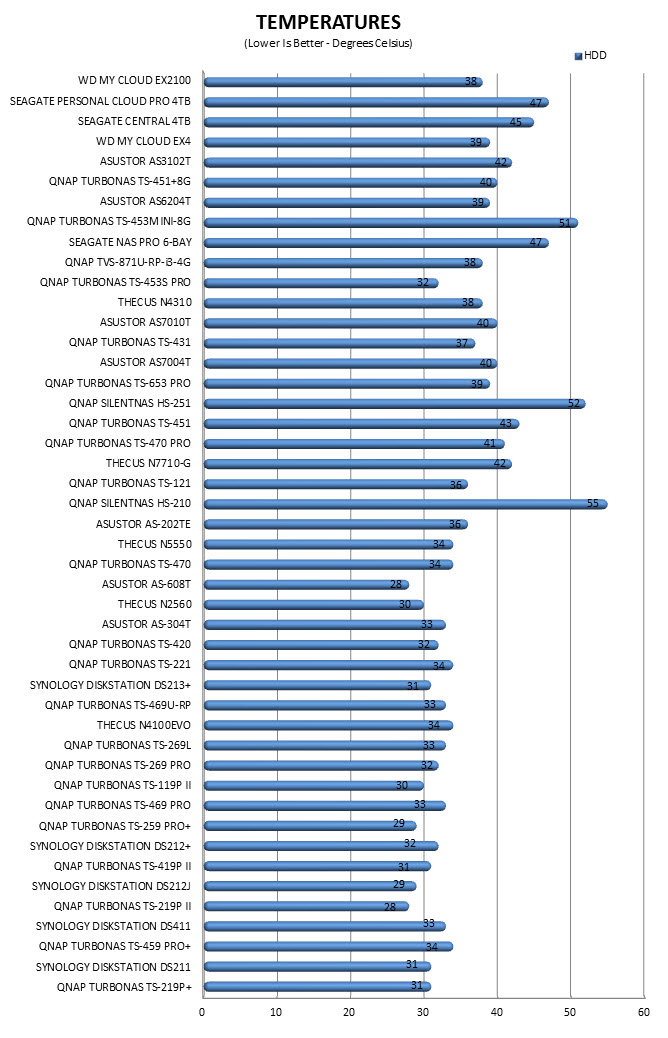
POWER CONSUMPTION

NOISE LEVELS

CONCLUSION
I didn’t hide my disappointment when we tested the My Cloud EX4 model a while back since it was indeed outdated compared to what we’ve been testing for the past 2 years and thus couldn’t compete with most in performance and to a large part features (it was priced extremely well however). Well the EX2100 is not among the highest-end NAS models currently in the market either but it’s actually a lot better compared to the EX4 both in terms of specifications and features. It does lack some useful features we see with most of its competition like a HDMI connector, out of the box support for IP cameras and the redundant power supply feature found in the EX4 (handy for 24/7 use) but overall it’s a much better choice (as is the EX4100). Power consumption and noise are also in good levels but what “steals” the show is the two WD Red drives used which work flawlessly with the NAS (as expected since both are manufactured by the same company). Of course just like with the EX4 the trayless hot-swap 3.5” bays of the EX2100 are a double edged sword since they are much faster to use but at the same time are not compatible with 2.5” drives (unless you use an adapter) and although most users will never use 2.5” drives with NAS servers some might.
The My Cloud EX4 might have been outdated but thanks to its very tempting price tag it still was a good choice for people on a budget. So how about the EX2100? Well as I type these lines the My Cloud Expert EX2100 8TB NAS retails for USD636.71 inside the USA (Amazon.com) and for 660Euros inside the EU (Amazon.co.uk) a price tag which is not half bad considering that just the two WD Red 4TB drives on their own currently retail for USD422/330Euros. In the end it all comes down to what your needs are and how much you’re willing to spend for a NAS server so if you don’t care about the media playback part and in terms of specifications the EX2100 could work for you then it’s a fine choice. On the other hand there are far more powerful models in the market today but they do cost quite a bit more and in the end do you really need something that much better? The decision is yours but for us the WD My Cloud Expert EX2100 8TB NAS represents a very good value for money and that’s why it gets our Golden Award.
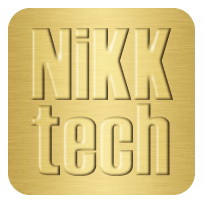
PROS
- Build Quality
- Very Good Performance
- Trayless Design
- User Friendly GUI
- Power Consumption
- Pre-Configured (Factory Ready)
- Price (For Some)
CONS
- No Surveillance Feature (Extra)
- No HDMI Output
- Not Compatible With 2.5” Drives

 O-Sense
O-Sense























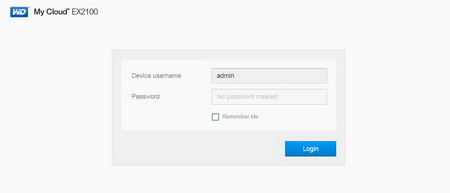




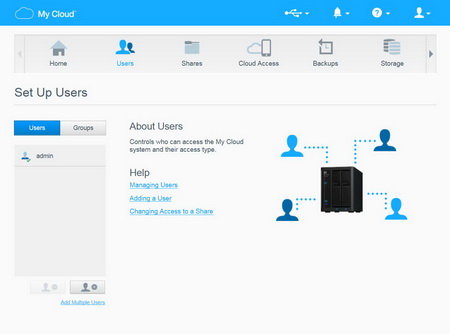

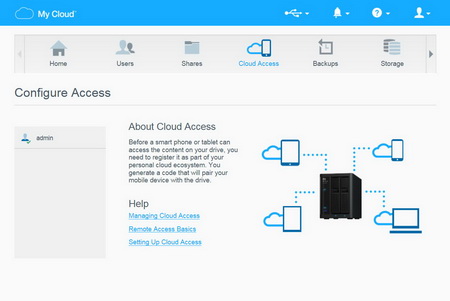
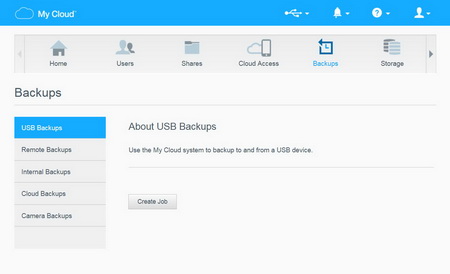




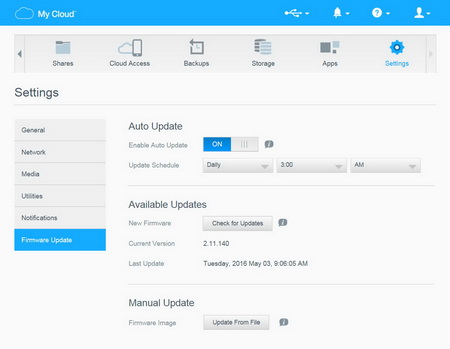



.png)

